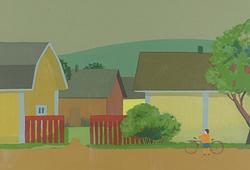Hilma af Klint
"Sotarpojkar Stigberget"
Signed H. af Klint and dated 1890. Oil on canvas 80 x 117 cm.
Alkuperä - Provenienssi
Acquired in the early 20th century.
Thence by descent.
Kirjallisuus
"Hilma af Klint, Catalogue Raisonné", volume 7, Bokförlaget Stolpe, Stockholm, 2022.
Muut tiedot
Hilma af Klint was a pioneer in many respects. Her artistic career began in classical painting, and she was among the first generations of female students admitted to the Royal Academy of Fine Arts in Stockholm.
In this painting, Hilma af Klint depicts a team of chimney sweep boys on Stigbergsgatan in Söder, Stockholm. It is an academic work from the period after her graduation from the Royal Academy of Fine Arts in 1888. Along with a few female colleagues, she shared a studio at Hamngatan 5 near Kungsträdgården in Stockholm. In the upper floors of the so-called Atejéhuset, there were studios and residences for students who had completed their studies. It was the cultural hub of the time, with Blanchs Café and the Art Salon on the ground floor.
Historian Dick Harrisson described the fate of the "chimney sweep boys" in an article in Svenska Dagbladet in 2017: "Chimney sweep boys and lads are mentioned in Swedish sources as early as the beginning of the 18th century, and they were still common at the end of the 19th century. They received ridiculously low wages: food, lodging, work clothes, and a sum of money that did not even guarantee they could eat their fill. According to the law, apprentices were supposed to be at least 14 years old, but this rule was ignored within the chimney sweeping industry. It is also worth noting that many chimney sweep boys did not work voluntarily. Often, chimney sweeps sourced their labour from orphanages and made foster children their employees."
Until her 40s, Hilma af Klint primarily painted portraits and landscapes, botanical studies, and commissioned works. Then, without any progressive transition, she shifted from traditional painting to creating abstract art in an absolutely free and unconventional manner. Long after her death, Hilma af Klint became internationally recognized and celebrated as an early pioneer of abstract art. From being virtually unknown, she is now equated with the greatest modern painters and her abstract works are considered groundbreaking. She has redrawn the map of early abstract art, both in Sweden and internationally.






















































